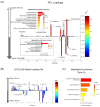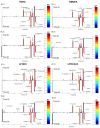Dietary Lipid Quantity and Quality Modulate the Postprandial Metabolomic Profile in Patients with Metabolic Syndrome
- PMID: 39770889
- PMCID: PMC11677668
- DOI: 10.3390/nu16244267
Dietary Lipid Quantity and Quality Modulate the Postprandial Metabolomic Profile in Patients with Metabolic Syndrome
Abstract
The literature on the postprandial metabolic changes in individuals with Metabolic Syndrome (MetS) remains limited, despite the fact that postprandial states represent the most common physiological condition in Western societies.
Background/objectives: The objective of this study was to investigate the plasma metabolomics profile in both fasting and postprandial states following a high-fat challenge in individuals with MetS who consumed diets with varying quantities and qualities of dietary fat over 12 weeks.
Methods: Seventy-five patients with MetS (28 males and 47 females) from the Spanish LIPGENE cohort were included in the study. MetS patients were randomly stratified to follow one of four dietary interventions (isoenergetic diets) for a 12-week long-term study. The four diets were high in saturated fatty acids and high in monounsaturated fatty acids (HSFA and HMUFA), low-fat high-complex carbohydrates (LFHCC), and LFHCC supplemented with n-3. The metabolomics analysis of plasma samples was carried out using Liquid Chromatography Time-of-Flight Mass Spectrometry (LC-TOF/MS).
Results: We observed a decrease in inflammation biomarkers, including acetylcarnitine and L-carnitine during the fasting state and hexanoyl-L-carnitine and isobutyryl-L-carnitine during the postprandial period, mediated by the replacement of HSFA with HMUFA. Additionally, antioxidant compounds such as 4-hydroxybenzaldehyde and L-valine were expressed at higher levels after consumption of the HMUFA diet compared to the HSFA diet. HSFA also presented altered levels of phosphatidylcholine, a metabolite previously linked with insulin resistance.
Conclusions: These findings suggest that replacing HSFA with HMUFA may reduce inflammation and improve antioxidant profiles, supporting the potential for tailored dietary interventions in individuals with MetS.
Keywords: MUFAs; SFA; inflammation; metabolic syndrome; metabolomics; oxidative stress.
Conflict of interest statement
The authors declare no conflicts of interest.
Figures




References
-
- Alberti K.G., Zimmet P.Z. Definition, diagnosis and classification of diabetes mellitus and its complications. Part 1: Diagnosis and classification of diabetes mellitus provisional report of a WHO consultation. Diabet. Med. 1998;15:539–553. doi: 10.1002/(SICI)1096-9136(199807)15:7<539::AID-DIA668>3.0.CO;2-S. - DOI - PubMed
-
- Saklayen M.G. The Global Epidemic of the Metabolic Syndrome. [(accessed on 29 March 2021)];Curr. Hypertens. Rep. 2018 20:12. doi: 10.1007/s11906-018-0812-z. Available online: https://www.ncbi.nlm.nih.gov/pmc/articles/PMC5866840/ - DOI - PMC - PubMed
Publication types
MeSH terms
Substances
Grants and funding
LinkOut - more resources
Full Text Sources
Medical

